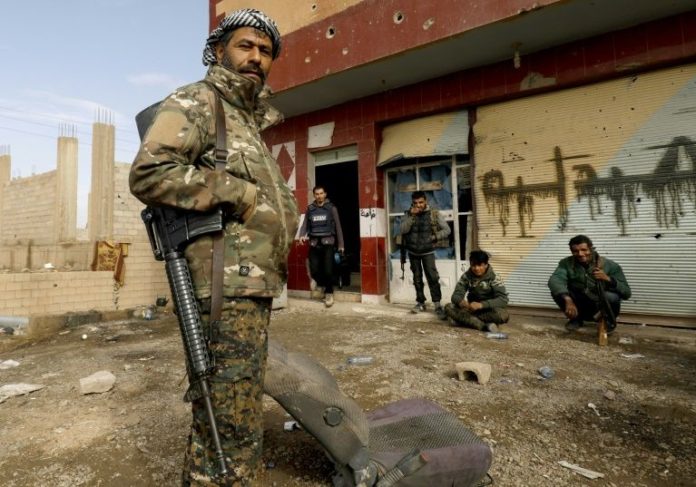OMAR OIL FIELD , Syria, Feb 17, 2019 (BSS/AFP) – Diehard jihadists have
blocked roads out of the last scrap of their Islamic State group “caliphate”
in Syria, US-backed forces fighting them said Sunday, preventing hundreds of
civilians from fleeing.
Ahead of a victory declaration expected within days and a subsequent US
military pullout, US President Donald Trump called on his European allies to
take back hundreds of alleged jihadists captured in Syria.
At a base for the Kurdish-led Syrian Democratic Forces behind the
frontline in eastern Syria, an AFP reporter heard airplanes darting in the
sky.
The jihadists declared a “caliphate” across large parts of Syria and
neighbouring Iraq in 2014, implementing their brutal interpretation of Islam
on millions. But several offensives have expelled them from all of it, except
a tiny patch of less than half a
kilometre square on the banks of the Euphrates river near the Iraqi border.
Thousands of people have streamed out of the so-called “Baghouz pocket” in
recent weeks, but hundreds of civilians — including IS family members — are
believed to still be inside.
SDF spokesman Mustefa Bali said IS had blocked roads out of their holdout,
preventing those remaining from escaping to safety.
“Daesh has sealed off all the streets,” he said, adding up to 2,000
civilians could still be inside.
IS is confined to “a few hundred metres square in… Baghouz with a number
of civilians they hold hostage and refuse to release”, he earlier said.
– ‘Human shields’ –
A spokesman for the US coalition, which has been backing the SDF with air
strikes, said IS was using these women and children as “human shields”.
“Civilians who have escaped are reporting ISIS is using them as human
shields and killing innocent civilians in order to intimidate others from
trying to leave,” Sean Ryan said.
Trump on Friday promised announcements linked to “the eradication of the
caliphate” within 24 hours, but a top SDF commander then warned the battle
would take a few more days.
The US president in December shocked allies when he announced he would
withdraw all 2,000 US troops from Syria because IS had been “beaten”.
That plan is set to be accelerated after a victory announcement.
Since 2015, the SDF have been battling IS with backing from the
international coalition, retaking one major town after another until reaching
Baghouz.
They have detained hundreds of foreigners accused of fighting for IS and
repeatedly called on their countries to repatriate them, but Western nations
have been reluctant.
Trump early Sunday called on his European allies to bring their nationals
home.
“The Caliphate is ready to fall,” he said on Twitter.
“The United States is asking Britain, France, Germany and other European
allies to take back over 800 ISIS fighters that we captured in Syria and put
them on trial,” he said, using an alternative acronym for IS.
“The alternative is not a good one in that we will be forced to release
them.”
“The US does not want to watch as these ISIS fighters permeate Europe,
which is where they are expected to go.”
– ‘Sleeper cells’ –
Beyond Baghouz, IS still has thousands of fighters and sleeper cells
scattered across several countries.
In Syria, it retains a presence in the vast Badia desert, and has claimed
deadly attacks in SDF-held territory.
The US Department of Defence has warned that without sustained
counterterrorism pressure, IS could resurge within months.
“Over the past month, more than one foreign sleeper cell was arrested in
multiple areas in Syria,” spokesman Bali said Sunday.
Acting Pentagon chief Patrick Shanahan has struggled to convince sceptical
allies in the international coalition to help secure Syria once US soldiers
pull out.
Any withdrawal would leave Syria’s Kurds exposed to a long-threatened
attack by neighbouring Turkey, which views Kurdish fighters as “terrorists”.
To prevent this, they have scrambled to seek a new ally in the Damascus
government after spending most of Syria’s civil war working towards self-
rule.
Eight years into the conflict that has killed more than 360,000 people,
President Bashar al-Assad’s government controls nearly two-thirds of the
country.
But the SDF hold around a third of the country still beyond its control.



